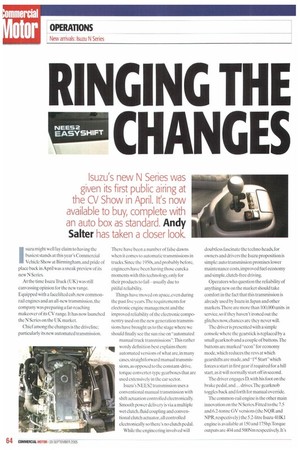R NGING THE 1 CHANGES
Page 66

Page 67

If you've noticed an error in this article please click here to report it so we can fix it.
Isuzu's new N Series was given its first public airing at
the CV Show in April. It's now available to buy, complete with
an auto box as standard. Andy Salter has taken a closer look.
Isum might well lay claim to having the busiest stands at this year's Commercial Vehicle Show at Birmingham, and pride of place back in April was a sneak preview of its new N Series.
At the time Isuzu Truck (UK) was still canvassing opinion for the new range. Equipped with a facelifted cab, new commonrail engines and an all-new transmission, the company was preparing a far-reaching makeover of its CV range. It has now launched the N Series on the UK market.
Chief among the changes is the driveline: particularly its new automated transmission. There have been a number of false dawns when it comes to automatic transmissions in trucks. Since the 1950s, and probably before, engineers have been having those eureka moments with this technology, only for their products to fail — usually due to pitiful reliability.
Things have moved on apace, even during the past five years.The requirements for electronic engine management and the improved reliability of the electronic componentry used on the new generation transmissions have brought us to the stage where we should finally see the sun rise on "automated manual truck transmissions".This rather wordy definition best explains them: -go automated versions of what are, in many cases, straightforward manual transmissions, as opposed to the constant-drive. torque converter-type gearboxes that are used extensively in the car sector.
Isuzu's NEES2 transmission uses a conventional manual transmission with shift actuation controlled electronically. Smooth power delivery is via a multiple wet clutch.fluid coupling and conventional clutch actuator, all controlled electronically so there's no clutch pedal.
While the engineering involved will doubtless fascinate the techno heads, for owners and drivers the Isuzu proposition is simple: auto transmission promises lower maintenance costs, improved fuel economy and simple, clutch-free driving.
Operators who question the reliability of anything new on the market should take comfort in the fact that this transmission is already used by Isuzu in Japan and other markets.There are more than 100,000 units in service, so if they haven't ironed out the glitches now, chances are they never will.
The driver is presented with a simple console where the gearstick is replaced by a small gearknob and a couple of buttons The buttons are marked "econ" for economy mode, which reduces the revs at which gearshifts are made, and "lst Start" which forces a start in first gear if required for a hill start, as it will normally start off in second.
The driver engages D, with his foot on the brake pedal, and... drives.The gearknob toggles back and forth for manual override.
The common-rail engine is the other main innovation on the N Series. Fitted to the 7.5 and 6.2-tonne GV versions (the NOR and NPR, respectively) the 5.2-litre lsuzu 4HK1 engine is available at 150 and 175hp.Torque outputs are 404 and 500Nm respectively. It's lighter than the previous unit and is expected to offer better fuel econotnyThe top rating is available only with the manual transmission.
The 3.0-litre,130hp unit that powers the 3.5 and 5.0-tonne versions of the N Series stays in the line-up.
The cab has also received an exterior restyle, and while the interior remains virtually unchanged from the outgoing model a fully suspended seat is now available, air-con is an option and the dark-grey interior trim should be simple to keep clean.
On the road
With the NOR loaded to within a whisker of its 7.5-tonne legal maximum we were surprised how lively it felt on the road.The 150hp common-rail engine is a quiet, yet eager power unit and the auto box skips up through the gears swiftly and without fuss:1'11e gearchanges are smooth, if a little slow, and we were able to concentrate on weaving through the busy South London streets while the electronics ensured we were in the right gear.
For most of the drive we left the system in automatic and in most circumstances it performed well, although it did want to hunt for the highest gear all the time. Normally that's a good thing, but the software appears to be pre-programmed to always make a gearshift at the same point, which means that as soon as you reach 2,900rpm in normal driving mode it will change up (upshifts are made at 2400rpm in economy mode).
On hills this meant the system had to change down more or less immediately when it discovered the gradient was too steep for the higher gear. Other systems on the market seem more sensitive to the load on the engine and will hold on longer if conditions dictate.
There is an over-ride facility, but we'd like auto to show a bit more intelligence.
As Isuzu pointed out, our test vehicle was a Japanese-built machine -UK series production will come from Portugaland as such did not benefit from the latest software updates to the transmission.We'll have to take their word for it and we've been promised a UK-spec machine for roadtest in the coming months.
That said, our few niggles shouldn't put you off the new N Series. It doesn't seem to be the most technically advanced option on the market, and yes, there are faster shifting alternatives, but Isuzu is the only company with the balls to make it a standard offering.
We're not sure drivers will notice their shift is slightly slower than a rival's providing they get the job done safely and with less effort. •






























































































































































































